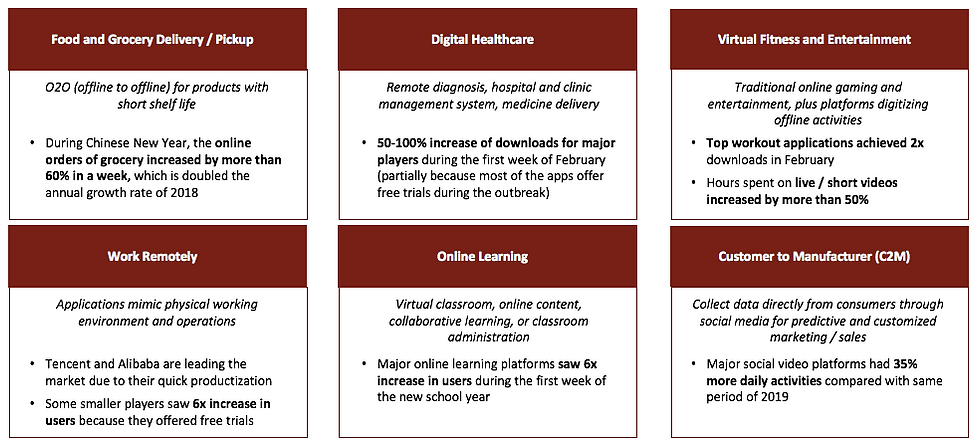During and After - a Reflection on Tech from the Lockdown in China
- Niki Liu
- Apr 16, 2020
- 3 min read
Since mid-march, China has been gradually lifting the social-distancing and re-opening the economy after a painful two-month strict lockdown caused by COVID-19. On April 8th, the city of Wuhan re-opened, marking the lockdown was reaching an end in China, but the number of new cases of COVID-19 is still closely monitored to prevent a second wave of outbreak.
China reported a 36.6% drop in GDP in the first quarter of 2020, and ~40% fewer VC deals compared with 2019. Among the ~US$9Bn investment during the period, two mega-rounds in Kuaishou, one of the two leading short video platform, and Yuan, an online K-12 tutoring platform, secured US$3Bn and US$1Bn, respectively, representing nearly half of the reported investment. [1] Not surprisingly, the investments moved “online” and the underlying technologies enabling it.
What has boomed when the economy halted?
Products to enable remote work, study, entertainment, and household activities exist and been caught the eyes of investors for a while. The lock-down made them inevitable.
During the first month of the lockdown, the user base of food and grocery delivery and digital healthcare increased for at least 50%, while the number for online learning and remote work is about 600%. Notably, the most catalyzed sector might be the Customer to Manufacturer (“C2M”) model and its changing value chain.

What will happen after the pandemic?
Although how long the pandemic will last and how the economy will recover are still unknown, some preliminary analysis has been put in place for how sustainable the six virtual sectors mentioned above will be after the pandemic and been put in the circumstances in Canada.
After the business goes back to normal, some of the virtual services will likely be considered a luxury again. Food and grocery delivery is accused to have too high a service/delivery fee even during the lockdown, which may only suit for dense urban areas when businesses go back to usual. Some activities are simply difficult to maintain as a habit to take online, such as fitness, parties, or dating.
On the other hand, some sectors may be fundamentally changed and transform a whole value chain. Digital healthcare, for an instant, if it can be developed properly to meet the user desirability, can for the long-run solve the pain points of the public health care system by offloading the workload of healthcare workers with intelligent solutions, and by optimizing processes to better utilize the resources.
The sectors that are believed to have a radical impact are likely to be remote working and C2M. New norms will form after the pandemic on the way people work and shop and the tools and technology are needed to endorse them. We are not envisioning a whole new world of no one will go to an office or the city center turns into a ghost town. However, the products that enjoyed emerging growth will likely to enhance business processes and efficiency, such as cybersecurity, digital document processing, and virtual workforce management, etc.
For the past couple of years, the trend of manufacturers skipping the complex logistics and sales channel to utilize novel social media to directly sell to customers was booming. The lockdown has moved the adoption to the next level. CEOs of multinational corporations are selling their products through live streaming online, and the retail space dedicated special areas for brands to do online sales. Correspondingly, the technologies that are backing the new value chain have surfaced. AI is behind the scene of recommending content to customers or to auto-routing logistics and delivery. Also, startups are innovating software and hardware to support more vivid content production.


One last word
No matter what the circumstances, the principles of growing a successful product or business innovation will stay unchanged. Building sustainable advantages is the secret sauce to stand out in the long-term beyond all the bold, innovative, and radical ideas.
Reference
Comentarios